Exchange Currency
Bangladeshi Taka
The Taka is the currency of Bangladesh. Bangladesh Bank, the central bank of the country controls the issuance of the currency except one taka and two taka notes, which are the responsibility of Ministry of Finance of the government of Bangladesh. One taka is subdivided into 100 poisha.
In Bengali, the word „taka” is also commonly used generically to mean any money, currency, or notes. Thus, colloquially, a person speaking Bengali may use „taka” to refer to money regardless of what currency it is denominated in.
The British standardized the silver Rupee (INR) throughout India, and it became the principal medium of exchange. Its value fluctuated, relative to the British Pound, as the values of silver and gold fluctuated. The Rupee fluctuated between 27 pence in 1870 and 16 pence on June 26 1893 when India effectively went on the gold standard. The Indian Coinage and Paper Currency Act, No. 22 of 1899 established a Pound Sterling exchange standard, giving legal tender status to British Gold Sovereigns. Banknotes were issued by the Government of India from 1861 until 1937, and by the Reserve Bank of India from 1937 until 1948.
Initially, after gaining its independence, the Reserve Bank of India continued to issue banknotes and coins for Pakistan. The Pakistan Rupee (PKR) was introduced on April 1, 1948 as part of a currency union with India. The Rupee was made divisible into 100 Paise. Banknotes were issued by both the Government of Pakistan, and by the State Bank of Pakistan.
In 1971, the erstwhile province of East Bengal became the independent nation of Bangladesh with the Pakistan Rupee as its interim currency. The taka became Bangladesh's currency in 1972, replacing the Pakistani rupee at par. The word „taka” is derived from the Sanskrit term tanka which was an ancient denomination of silver coin. The term taka was widely used in different parts of India but with varying meanings. In north India, taka was a copper coin equal to two paise and in the south, it was equal to four paisa or one anna. It was only in Bengal and Orissa where taka was equal to rupee. In all areas of India, taka was used informally for money in general. However, Bengal was the stronghold of taka.
The rupee was introduced by the Turko-Afghan rulers and was strongly upheld by the Mughals and the British rulers. The Bengali and oriya people always used the word taka for the rupee, whether silver or gold. Ibn Battuta, the Arab traveller, noticed that, in Bengal, people described gold coins (Dinar) as gold tanka and silver coin as silver tanka. In other words, whatever might be the metallic content of the coin, the people of Bengal called it taka. When the Pakistan Rupee was issued prior to 1971 bearing both Urdu and Bengali alphabets, the word taka was used in Bangla version instead of rupiya, as in Urdu version.
In 2000, the government issued polymer 10 taka notes as an experiment (similar to the Australian dollar). They proved unpopular, however, and were withdrawn later. At present, the 1 taka and 5 taka notes are gradually being replaced with coins.
In 2008, the government issued 1000 taka notes.
In Bengali, the word „taka” is also commonly used generically to mean any money, currency, or notes. Thus, colloquially, a person speaking Bengali may use „taka” to refer to money regardless of what currency it is denominated in.
Summary info
Summary information about Bangladeshi taka- ISO 4217 Code:
- BDT
- Currency sign:
- ৳ or Tk
- Country:
- Bangladesh
- Subunit:
- paisa
- Coins:
- 1 paisa, 5 poisha, 10 poisha, 25 poisha, 50 poisha, 1 Taka, 2 Taka, 5 Taka
- Banknotes:
- 1 Taka, 2 Taka, 5 Taka, 10 Taka, 20 Taka, 50 Taka, 100 Taka, 500 Taka, 1000 Taka
- Central bank:
- Bangladesh Bank
History
After the British gained control of Bengal in 1772, the British East India Company began minting coins in Calcutta that circulated throughout Bengal. The East India Company made the Madras rupee of the weight established in 1818 the standard for all of India; it was therefore called the "Company's rupee." Calcutta (sicca) rupees ceased to be legal tender as of 1 January 1838 (East India Company, Act No. 13 of 1836). The 1835 act also provided for coining the gold mohur, which was done beginning 1 September 1835. East India Company, proclamation of 13 January 1841, explicitly allowed mohurs to be used in paying the government, though they were not legal tender for paying private persons. The effect was to make India quasi bimetallic at a ratio of 15 units silver =1 unit gold. Gold mohurs ceased to be legal tender on December 1, 1853 putting India on a silver standard. In 1862 the coinage was transferred from the East India Company to the Indian colonial government (India, Act No. 13 of 1862). In 1876, the government of India was allowed to admit coins of native states as legal tender upon certain conditions (India, Act No. 9 of 1876).The British standardized the silver Rupee (INR) throughout India, and it became the principal medium of exchange. Its value fluctuated, relative to the British Pound, as the values of silver and gold fluctuated. The Rupee fluctuated between 27 pence in 1870 and 16 pence on June 26 1893 when India effectively went on the gold standard. The Indian Coinage and Paper Currency Act, No. 22 of 1899 established a Pound Sterling exchange standard, giving legal tender status to British Gold Sovereigns. Banknotes were issued by the Government of India from 1861 until 1937, and by the Reserve Bank of India from 1937 until 1948.
Initially, after gaining its independence, the Reserve Bank of India continued to issue banknotes and coins for Pakistan. The Pakistan Rupee (PKR) was introduced on April 1, 1948 as part of a currency union with India. The Rupee was made divisible into 100 Paise. Banknotes were issued by both the Government of Pakistan, and by the State Bank of Pakistan.
In 1971, the erstwhile province of East Bengal became the independent nation of Bangladesh with the Pakistan Rupee as its interim currency. The taka became Bangladesh's currency in 1972, replacing the Pakistani rupee at par. The word „taka” is derived from the Sanskrit term tanka which was an ancient denomination of silver coin. The term taka was widely used in different parts of India but with varying meanings. In north India, taka was a copper coin equal to two paise and in the south, it was equal to four paisa or one anna. It was only in Bengal and Orissa where taka was equal to rupee. In all areas of India, taka was used informally for money in general. However, Bengal was the stronghold of taka.
The rupee was introduced by the Turko-Afghan rulers and was strongly upheld by the Mughals and the British rulers. The Bengali and oriya people always used the word taka for the rupee, whether silver or gold. Ibn Battuta, the Arab traveller, noticed that, in Bengal, people described gold coins (Dinar) as gold tanka and silver coin as silver tanka. In other words, whatever might be the metallic content of the coin, the people of Bengal called it taka. When the Pakistan Rupee was issued prior to 1971 bearing both Urdu and Bengali alphabets, the word taka was used in Bangla version instead of rupiya, as in Urdu version.
Coins
In 1973, coins were introduced in denominations of 5, 10, 25 and 50 poisha. 1 poisha coins followed in 1974, with 1 taka coins introduced in 1975. The 1, 5 and 10 poisha were struck in aluminium, with the 25 and 50 poisha struck in steel and the 1 taka in copper-nickel. The 5 poisha were square with rounded corners, whilst the 10 poisha were scalloped. Steel 5 taka were introduced in 1994, whilst a steel 2 taka coin followed in 2004. 1 and 5 poisha coins are rarely found in circulation. 10, 25, and 50 poisha coins do not circulate widely. Only the 1, 2 and 5 taka are regularly found in circulation.Banknotes
In 1971, Pakistani notes for 1, 5 and 10 rupees were overstamped for use in Bangladesh. These were followed in 1972 by treasury notes for 1 taka and notes of the Bangladesh Bank for 5, 10 and 100 taka. In 1975, banknotes for 50 taka were introduced, followed by 500 taka in 1977 and 20 taka in 1980. 1 taka treasury notes were issued until 1984, with 2 taka treasury notes introduced in 1989.In 2000, the government issued polymer 10 taka notes as an experiment (similar to the Australian dollar). They proved unpopular, however, and were withdrawn later. At present, the 1 taka and 5 taka notes are gradually being replaced with coins.
In 2008, the government issued 1000 taka notes.
BDT banknotes pictures gallery
| 1 Bangladeshi taka | |
|---|---|
| Banknote of 1 Bangladeshi taka has dimensions 100×60 mm and main colors are wheat, rose quartz, pale chestnut and pale silver. Date of first issue of this 1 Taka banknote is 3 September 1979. | |
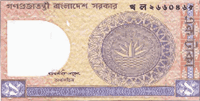 Obverse side of the 1 Bangladeshi taka is showing the national emblem. |
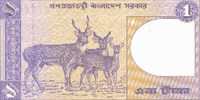 Reverse side of the 1 Bangladeshi taka is showing a picture of three spotted deer. |
| 2 Bangladeshi taka | |
|---|---|
| Banknote of 2 Bangladeshi taka has dimensions 100×60 mm and main colors are ash grey, almond, platinum and tea rose. Date of first issue of this 2 Taka banknote is 29 December 1988. | |
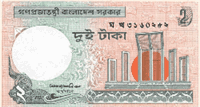 Obverse side of the 2 Bangladeshi taka is showing a picture of Shahid Minar of the Language Movement. |
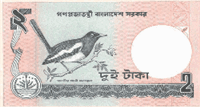 Reverse side of the 2 Bangladeshi taka is showing a picture of the National Bird-Doyel. |
| 5 Bangladeshi taka | |
|---|---|
| Banknote of 5 Bangladeshi taka has dimensions 119×64 mm and main colors are beaver, rosy brown, pale silver, pastel gray and timberwolf. Date of first issue of 5 Taka banknote is 8 October 2006. | |
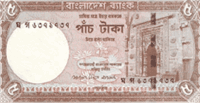 Obverse side of the 5 Bangladeshi taka is showing a picture of Mehrab of the Kusumbag Mosque. |
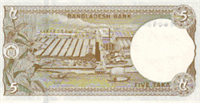 Reverse side of the 5 Bangladeshi taka is showing an industrial landscape with two sailing boats. |
| 10 Bangladeshi taka | |
|---|---|
| Banknote of 10 Bangladeshi taka has dimensions 122×59 mm and main colors are ruddy pink, copper rose, light gray and raspberry glace. Date of first issue of this 10 Taka banknote is 21 September 2006. | |
 Obverse side of the 10 Bangladeshi taka is showing the National Mosque (Bait-UL-Mukarram). |
 Reverse side of the 10 Bangladeshi taka is showing the national Parliament building. |
| 20 Bangladeshi taka | |
|---|---|
| Banknote of 20 Bangladeshi taka has dimensions 130×60 mm and main colors are khaki, davy’s grey, dim gray, trolley grey and pale silver. Date of first issue of this 20 Taka banknote is 13 July 2002. | |
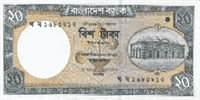 Obverse side of the 20 Bangladeshi taka is showing Choto Sona Mosque (on the right hand side). |
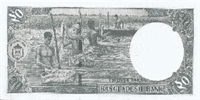 Reverse side of the 20 Bangladeshi taka is showing a picture showing 4 men washing jute in water beside a paddy field. |
| 50 Bangladeshi taka | |
|---|---|
| Banknote of 50 Bangladeshi taka has dimensions 130×60 mm and main colors are khaki, flax, sunset and beige. Date of first issue of this 50 Taka banknote is 30 July 2005. | |
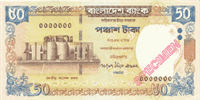 Obverse side of the 50 Bangladeshi taka is showing the national Parliament building. |
 Reverse side of the 50 Bangladeshi taka is showing the Bagha Mosque, Rajshahi. |
| 100 Bangladeshi taka | |
|---|---|
| Banknote of 100 Bangladeshi taka has dimensions 140×62 mm and main colors are pale aqua, gainsboro, pastel purple and ash grey. Date of first issue of this 100 Taka banknote is 16 July 2006. | |
 Obverse side of the 100 Bangladeshi taka is showing the national Memorial, Savar. |
 Reverse side of the 100 Bangladeshi taka is showing the image of Jamuna Bridge. |
| 500 Bangladeshi taka | |
|---|---|
| Banknote of 500 Bangladeshi taka has dimensions 153×69 mm and main colors are pale pink, gainsboro, rosy brown and platinum. Date of first issue of this 100 Taka banknote is 24 October 2004. | |
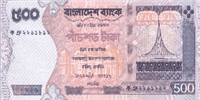 Obverse side of the 500 Bangladeshi taka is showing the national Monument and Saat Masjid. |
 Reverse side of the 500 Bangladeshi taka is showing the Supreme Court Building, Dhaka. |
| 1000 Bangladeshi taka | |
|---|---|
| Banknote of 1000 Bangladeshi taka has dimensions 160×72 mm and main colors are mauvelous, pink pearl, lavender blush, puce and pastel magenta. Date of first issue of this 100 Taka banknote is 27 October 2008. | |
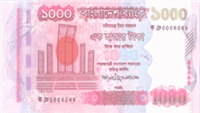 Obverse side of the 1000 Bangladeshi taka is showing the national Shaheed Minar. |
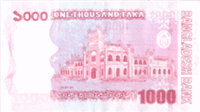 Reverse side of the 1000 Bangladeshi taka is showing the Curzon Hall, Dhaka University. |
Useful links
- About Bangladesh Bank:
- Bangladesh Bank
- List of currencies:
- Currencies
- Security and design features of BDT banknotes:
- BDT banknotes
- BDT currency on Wikipedia:
- Bangladeshi taka
- Official Website of Bangladesh Bank:
- www.bangladesh-bank.org
- Commemorative coins:
- Commemorative Coins